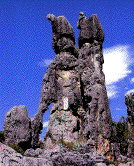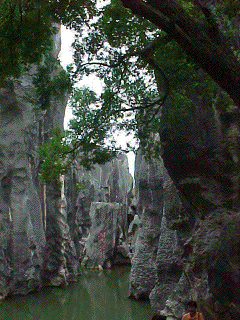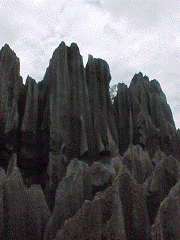 The Stone Forest is a typical Karst morphological region. Under the controlling geological, hydrologic and climatic factors, the carbonate rock has undergone several periods of modification by the downward migration of surface water and ground water. The present karst morphology in the area formed over millions of years.
The Stone Forest is a typical Karst morphological region. Under the controlling geological, hydrologic and climatic factors, the carbonate rock has undergone several periods of modification by the downward migration of surface water and ground water. The present karst morphology in the area formed over millions of years.The locals seemed to have named nearly every eroded surface.
Question ..... Can you guess the name of the formation on the left? (see the end of this section for the answer).
The following is slightly modified from material supplied by the Yunnan Institution of Geosciences.
Introduction
The area known as the Lunnan karst wonder occupies approximately 900 square kilometers of which about 300 square kilometers constitute a State-designated strategic scenic area . The main scenic areas include the Major, Minor and Naigu Stone Forests, Zhiyun Cave, Jibailong Cave, Qifeng Cave, Lunar Lake, Long Lake, and Big Water Fall.
 "The Major and Minor Stone Forests as considered to be outstanding examples of karst topography in the world. Situated in the upper part of the nearly pure limestone (primarily CaCO3) of the Permian Makou Formation, the rocks are extremely weirdly shaped, looking like animals or human beings. These scenic spots are given interesting names such as "birds feeding their young", "phoenix preening itself", "glossy ganoderma of eternity" and so on, making visitors always give full-play to their imagination. Approximately 85km southeast of Kunming City and 15km northeast of Lunan County, they are easily accessible along a second-rank highway (Geological Excursion Guidebook to the Karst Landscape in the Lunang Region, Yunnan Province).
"The Major and Minor Stone Forests as considered to be outstanding examples of karst topography in the world. Situated in the upper part of the nearly pure limestone (primarily CaCO3) of the Permian Makou Formation, the rocks are extremely weirdly shaped, looking like animals or human beings. These scenic spots are given interesting names such as "birds feeding their young", "phoenix preening itself", "glossy ganoderma of eternity" and so on, making visitors always give full-play to their imagination. Approximately 85km southeast of Kunming City and 15km northeast of Lunan County, they are easily accessible along a second-rank highway (Geological Excursion Guidebook to the Karst Landscape in the Lunang Region, Yunnan Province).
The Naigu Stone Forest, so named because of its weathered black surface ( Naigu means "black" in the local ethnic language, Sani), is 9 km northeast of the Major Stone Forest. It is developed in the dolomite (CaMg(CO3)2 and limestone of the Permian Qixia Formation and is represented by unique shapes like mushrooms, resulting from the differential dissolution of the different lithologies.
Dissolution lakes of enchanting and picturesque scenery, the Lunar Lake and Long Lake for example, are widespread in the Lunan region. The Big Waterfall is situated in the southeast of Lunan County and 19 km away from the downtown area. It flows swiftly over the 90 m fall and is the most spectacular waterfall in Yunnan Province.
The Lunan caverns -- Zhiyun Cave, Jibailong Cave among others --. make up another fascinating world. The Shima Dragon Palace, which resembles a fairyland dragon palace, is concealed underground at depths of 100m or more. In particular , a magical scenery named "dragons groaning and tigers roaring" in Qifeng Cave is a natural creation and a true masterpiece of geological agents.
Strata and Lithology
 The main strata in the Stone Forest area include the carbonate rocks of the Qixia Formation and Maokou Formations of Lower Permian age. These units average 505 m thick and consist of shallow sea platform facies, massive dolomites, bio-clastic limestones, calcarenites and calcilutites. Most of the carbonate rock in the area is coarsely crystalline which makes dissolution relatively easy. Interbedded units with higher percentages of acid insoluble residue form mushroom-like shapes as compared with the sharp-edged shapes developed in the relatively pure limestone units.
The main strata in the Stone Forest area include the carbonate rocks of the Qixia Formation and Maokou Formations of Lower Permian age. These units average 505 m thick and consist of shallow sea platform facies, massive dolomites, bio-clastic limestones, calcarenites and calcilutites. Most of the carbonate rock in the area is coarsely crystalline which makes dissolution relatively easy. Interbedded units with higher percentages of acid insoluble residue form mushroom-like shapes as compared with the sharp-edged shapes developed in the relatively pure limestone units.
Structural Controls
 The strata are part of a westward dipping (2 to 6 o) monocline. Conjugate shear joints (NE-SW and NE-SE) are well developed and these fractures provided the main passageways for surface water and underground water in the pre-kart development stage. The distribution, density and orientation of the fractures controlled the depth, size and orientation of the karst topography.
The strata are part of a westward dipping (2 to 6 o) monocline. Conjugate shear joints (NE-SW and NE-SE) are well developed and these fractures provided the main passageways for surface water and underground water in the pre-kart development stage. The distribution, density and orientation of the fractures controlled the depth, size and orientation of the karst topography.
Morphologic and Hydrogeologic Factors
. Sandstones and shales of Liangshan Formation that lies below the carbonate rock formations serve as a permeability barrier and force the local groundwater to flow from west to east.
Watch the following animation to see one way that a karst topography can develop.
Answer ..... Camel on Elephant!